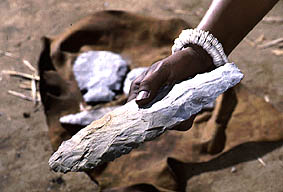
Mill Creek Chert hoe, Illinois State Museum.

Mill Creek Chert hoe, Illinois State Museum. |
It is likely that the evolving Mississippian reliance on maize farming promoted and benefited from several technological innovations -- in particular the broad, chert hoe. Hoes made from Mill Creek Chert, were stronger and more durable than hoes previously made from shell or bone. In comparison to other nearby chert sources, Mill Creek appears to be ideal for hoe manufacture and use. Although other cherts are equally fine-grained, Mill Creek Chert occurs as relatively large tabular nodules, a shape well suited for the manufcture of broad bifaces. Certainly its ubiquity and the almost total lack of hoes made from other cherts indicates that Mississippian farmers found that Mill Creek Chert hoes made agricultural work easier. |
Although not known from the American Bottom, other Mississippian sites in the Midwest contain another technological innovation, the ridged field. Ridged fields consist of rows of earth piles in which maize and other seeds were planted. One hypothesis is that ridged fields may have permitted earlier planting by creating more surface area to absorb sunlight thereby protecting early shoots from frost.
Technological innovations impacted not only subsistence, but other aspects of the Mississippian economy as well. Clearing the large amounts of land that could now be efficiently worked, for example, likely required significantly more labor than the small family gardens of pre-Mississippian horticulturists. Thus, individual families may not have had the labor resources for the construction or maintenance of large fields. Like land clearing, some organization of labor beyond the household may have been required.
The efficacy of Mill Creek chert hoes and their importance to Mississippian farmers are reflected in the development of large chert quarries in the Shawnee Hills and the movement of large volumes of Mill Creek chert into the American Bottom for several hundred years. No matter how these stone quarrying, trading, and hoe-making activities were organized -- be it specialized traders and hoe-making craftsmen (less likely), or individual farmers making yearly treks south to quarry and make their personal hoes (more likely), or down-the-line trading of complete hoes from village to village (always likely) -- chert mining and manufacture of chert hoes were clearly important to maize agriculture and to the Mississippian economy as a whole.